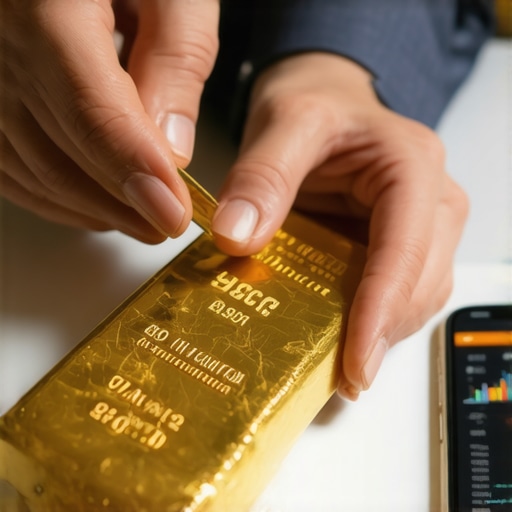Understanding the Importance of Gold as an Investment
Buying gold can seem daunting, especially for first-time buyers. However, gold remains a highly sought-after investment due to its historical stability and status as a hedge against inflation. Whether you’re looking to diversify your portfolio or secure your wealth, understanding how to buy gold smartly is crucial.
Identifying the Right Type of Gold Investment
There are various forms of gold investments available, including physical gold (like bullion and coins) and financial products (such as gold ETFs and mutual funds). Each option has its own advantages and disadvantages. For instance, physical gold can provide tangible security, while gold ETFs offer liquidity and ease of trading.
Physical Gold vs. Financial Products
When considering physical gold, it’s essential to evaluate whether you prefer owning an asset you can hold in your hand or if you’re more comfortable with a digital representation of gold. Physical gold requires storage and insurance, while ETFs and gold stocks can be managed through brokerage accounts.
Researching Gold Prices and Market Trends
Before purchasing, it’s vital to understand current market trends and prices. Keep an eye on factors influencing the price of gold, such as economic stability, interest rates, and geopolitical tensions. For insights on upcoming gold price movements, check out our article on gold price forecasts.
Timing Your Purchase
Timing can play a significant role in your gold investment strategy. Many investors prefer to buy during market dips to maximize their returns. Analyzing gold prices today can help you identify potential opportunities for purchase, allowing you to buy low and sell high.
Finding Reputable Dealers
Once you’ve decided on the type of gold to buy, the next step is finding a reputable dealer. Look for dealers with positive reviews, certifications, and transparent pricing. To make informed decisions, consider reading the best gold investment tips for beginners article for guidance on selecting trustworthy sources.
Understanding Markups and Premiums
When buying gold, be aware that dealers often charge markups and premiums over the spot price. Understanding these costs will ensure you know exactly what you’re paying. For a more in-depth look at evaluating these costs, read our piece on evaluating gold investments.
Storing Your Gold Securely
After making your purchase, consider your storage options. Secure storage is vital to protect your investment. Options include home safes, bank safety deposit boxes, or specialized gold storage facilities. Each option comes with its own costs and benefits, so evaluate which method aligns best with your needs.
Evaluating Gold Investment Costs
Understanding the costs associated with gold investments is crucial for first-time buyers. In addition to the purchase price, you should consider various fees, including dealer markups and storage costs. When analyzing gold investments, ensure you factor in these additional costs to get a clear picture of your potential returns.
Understanding Dealer Fees
Dealers often charge a premium over the spot price of gold, which can vary significantly. This premium compensates them for their services and profit margin. To make informed decisions, it’s wise to compare prices among several dealers and look for any hidden fees. You can find more about this in our article on best gold investment tips for beginners.
Choosing the Right Storage Method for Your Gold
Once you have made your purchase, deciding how to store your gold securely is essential. The right storage method will depend on your personal circumstances, including how much gold you own and your comfort level with risk.
Home Safes vs. Bank Deposits
Many investors opt for home safes because they provide immediate access to their gold. However, this option can pose risks related to theft or damage. Alternatively, bank safety deposit boxes offer a secure storage solution but may come with rental fees. If you want to explore more about storage options, check our guide on what to know before buying gold bullion.
Understanding Gold Market Trends
Staying informed about gold market trends is vital for making smart investment decisions. Gold prices fluctuate based on a variety of factors, including economic indicators and global events. By keeping an eye on these trends, you can better time your purchases and sales.
Using Market Analysis Tools
Leverage market analysis tools and resources to track gold prices effectively. Websites that offer real-time updates can provide insights into current trends and help you anticipate potential changes in the market. For a deeper understanding of market dynamics, consider reading our post on latest gold market analysis.
Building a Diversified Gold Portfolio
As you grow more comfortable with gold investments, consider diversifying your portfolio. A well-rounded approach can mitigate risks and enhance your overall returns. Diversifying might involve a mix of physical gold, gold ETFs, and mining stocks.
Benefits of Gold ETFs and Mining Stocks
Gold ETFs offer an opportunity to invest in gold without the need for physical storage, while mining stocks can provide leverage to gold prices. Each option has its own risk-reward profile, so it’s essential to evaluate what aligns with your investment strategy. For insights on choosing between these options, read our article on gold stocks vs. mutual funds.
Exploring Advanced Gold Investment Techniques
As you delve deeper into the world of gold investment, it’s essential to understand advanced techniques that can enhance your portfolio’s performance. Whether you’re a seasoned investor or just starting, these strategies can help you navigate the complexities of the gold market.
Utilizing Gold Futures for Investment Flexibility
Gold futures contracts offer an opportunity to invest in gold without actually owning the physical asset. This strategy allows investors to speculate on the future price of gold, providing flexibility and potential for significant returns. However, trading futures requires a firm grasp of the market dynamics and risk management. To learn more about how to navigate these instruments, explore our article on exploring gold futures.
The Role of Gold IRAs in Wealth Preservation
Gold Individual Retirement Accounts (IRAs) can be an effective way to protect your retirement savings against market volatility. By investing in gold through an IRA, you not only benefit from the potential appreciation of gold but also enjoy tax advantages. Understanding the rules and regulations associated with gold IRAs is crucial to maximizing their benefits. For detailed insights, check out our guide on understanding the benefits of gold IRAs.
Choosing the Right Gold IRA Provider
When selecting a provider for your gold IRA, ensure they have a solid reputation and offer a range of gold products that meet IRS standards. Look for transparency in fees and clear communication about the investment process. To navigate the complexities of setting up a gold IRA, consider reading our article on how to buy gold.
Understanding Gold Market Analysis Techniques
To make informed investment decisions, it’s vital to employ effective gold market analysis techniques. This involves studying price trends, economic indicators, and geopolitical events that can influence gold prices. Fundamental analysis helps you understand the underlying factors driving the gold market, while technical analysis focuses on price movements and market sentiment.
Combining Fundamental and Technical Analysis
Combining both fundamental and technical analysis can provide a comprehensive view of the market. For instance, while fundamental analysis may reveal that economic instability is driving gold prices up, technical analysis can help you identify the best entry and exit points for your investments. To enhance your skills further, read about our gold price forecasts that incorporate both analysis methods.
Leveraging Gold ETFs for Portfolio Diversification
Gold Exchange-Traded Funds (ETFs) are an excellent tool for diversifying your investment portfolio. Unlike physical gold, gold ETFs offer liquidity and can be traded like stocks, providing a practical solution for investors looking to gain exposure to gold without the challenges of storage and insurance. Understanding the nuances of different gold ETFs can help you select the right one for your investment strategy.
Evaluating the Performance of Gold ETFs
When evaluating gold ETFs, consider factors such as expense ratios, tracking error, and the fund’s underlying gold holdings. It’s essential to choose a fund that closely tracks the price of gold to maximize your investment potential. For a comprehensive comparison of gold ETFs, check our article on analyzing gold ETF returns.
Staying Updated with Gold Market News
In the fast-paced world of gold investment, staying updated with market news is critical. Economic reports, central bank policies, and geopolitical events can all impact gold prices significantly. Subscribing to reputable financial news sources can provide valuable insights and help you make informed decisions.
Joining Gold Investment Communities
Engaging with other gold investors through online communities or local investment clubs can offer additional perspectives and tips. Sharing experiences and strategies can enhance your understanding of the market. To further explore community-driven insights, consider our resources on top gold investment strategies.
Understanding Gold Investment Risks and Rewards
Investing in gold can be lucrative, but it also comes with its fair share of risks. Understanding these risks is crucial to making informed decisions. Market volatility, changes in economic conditions, and geopolitical events can all impact gold prices. For detailed insights into what drives these changes, check out our article on key factors driving gold price trends.
Risk Management Techniques
Implementing effective risk management strategies can help protect your investment. Diversification, for instance, allows you to spread your investments across various asset classes, reducing exposure to any single investment. Consider incorporating gold ETFs, mining stocks, and physical gold into your portfolio. To explore how to diversify effectively, read our post on top gold investment strategies for profitable returns.
Utilizing Gold Mining Stocks
Gold mining stocks can be a powerful addition to your investment strategy. These stocks represent companies involved in gold extraction, and their value often correlates with gold prices. Investing in mining stocks can provide leverage, meaning that when gold prices rise, mining stocks might increase in value even more significantly.
Evaluating Mining Stocks
When considering mining stocks, assess the company’s production costs, reserves, and management team. Understanding the mining industry’s dynamics is essential for identifying promising investments. For a deeper dive into investing in mining stocks, check our guide on what to know about gold mining stocks.
The Impact of Central Bank Policies
Central banks play a vital role in the gold market. Their policies on interest rates and gold purchases can significantly influence gold prices. Monitoring central bank activities can help you anticipate market movements and make timely investment decisions. For more insights on this topic, refer to our article on how central bank purchases impact gold demand.
Understanding Monetary Policy Effects
Changes in monetary policy, such as interest rate adjustments, can affect investor sentiment towards gold. Lower interest rates often lead to higher gold prices as the opportunity cost of holding gold decreases. Keeping abreast of economic indicators and central bank announcements can provide valuable insights for your investment strategy.
Gold as a Hedge Against Inflation
Gold is often viewed as a hedge against inflation. When inflation rises, the value of currency may decline, leading investors to seek refuge in gold. Understanding how gold performs during inflationary periods can guide your investment decisions. For expert insights, explore our article on exploring the stability of gold as a hedge against inflation.
Investing During Economic Uncertainty
In times of economic uncertainty, gold often shines as a safe haven. Investors flock to gold to preserve their wealth when markets are volatile. By incorporating gold into your portfolio, you can enhance its resilience against economic downturns. Consider reading our comprehensive guide on 2025 gold demand trends for more information on investment strategies during uncertain times.
Frequently Asked Questions About Gold Investment
What are the advantages of investing in gold?
Gold offers several advantages, including its historical stability, potential for high returns, and ability to act as a hedge against inflation and economic uncertainty. It also enhances portfolio diversification and tends to retain value over time.
How do I start investing in gold?
To start investing in gold, you can choose between physical gold (like coins and bullion) and gold-related financial products (such as ETFs and stocks). Research your options, compare prices, and select a reputable dealer or platform to make your purchase.
What is the best way to store gold?
The best way to store gold depends on your preferences and the amount you own. Options include home safes, bank safety deposit boxes, and specialized storage facilities. Consider security, accessibility, and costs when choosing your storage method.
Are gold IRAs a good investment?
Gold IRAs can be a great investment for retirement savings. They allow you to invest in physical gold while enjoying tax benefits. However, it’s essential to understand the rules and fees associated with gold IRAs before proceeding.
What factors influence gold prices?
Gold prices are influenced by various factors, including economic indicators, geopolitical events, inflation rates, and central bank policies. Monitoring these elements can help you make informed investment decisions.
How do gold ETFs work?
Gold ETFs are funds that track the price of gold and can be traded like stocks on an exchange. They offer liquidity and diversification without the need to physically store gold. Investors can gain exposure to gold prices without the complexities of physical ownership.
What are the risks associated with gold investment?
Risks include market volatility, fluctuating prices, and the potential for lower returns compared to other investment types. Additionally, investing in gold mining stocks can introduce operational risks related to the mining industry.
Is it better to buy physical gold or gold stocks?
Buying physical gold provides tangible security, while gold stocks can offer higher leverage and potential returns. The best choice depends on your investment strategy, risk tolerance, and market outlook.
How can I evaluate gold investment performance?
To evaluate gold investment performance, analyze price trends, compare against benchmarks, and consider factors like expenses and fees associated with your investment vehicles. Regularly review your portfolio to ensure it aligns with your financial goals.
Authority Resources for Gold Investment
For further insights and expert advice on gold investment, consider exploring the following trusted resources:
- Kitco News – A leading platform for market analysis and gold price updates.
- World Gold Council – Provides research and insights on gold trends and its role in finance.
- Investopedia – Offers educational articles and guides on investing in gold and other assets.
- Bloomberg – A reputable source for financial news and market information.
- JSTOR – Access academic literature and research studies on gold and economic trends.
Conclusion
In conclusion, investing in gold presents a powerful opportunity for both novice and seasoned investors. By understanding the various forms of gold investments, market trends, and the importance of secure storage, you can build a robust strategy that enhances your financial portfolio. Remember that gold serves not only as a valuable asset but also as a reliable hedge against inflation and economic instability. With the right knowledge and resources, you can navigate the gold market confidently and make informed decisions that align with your investment goals.









